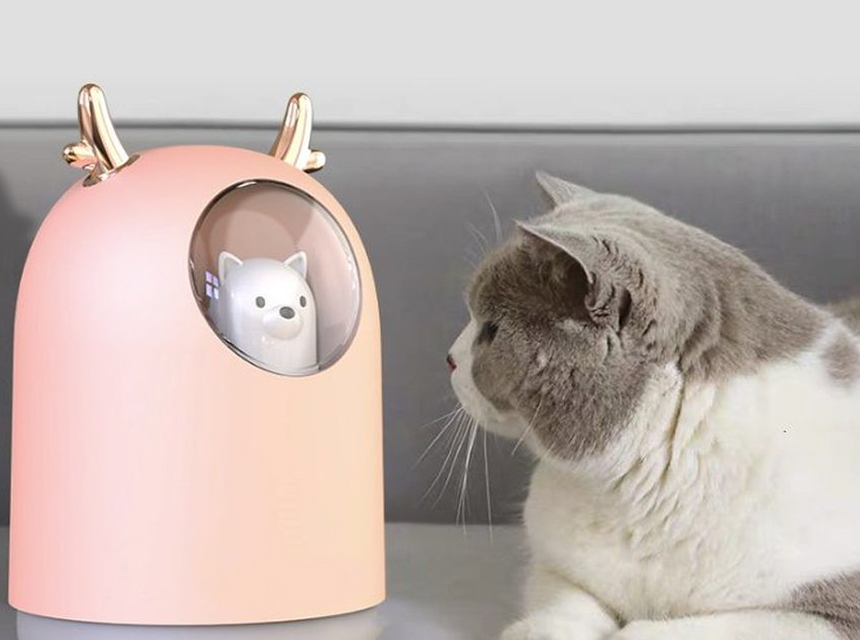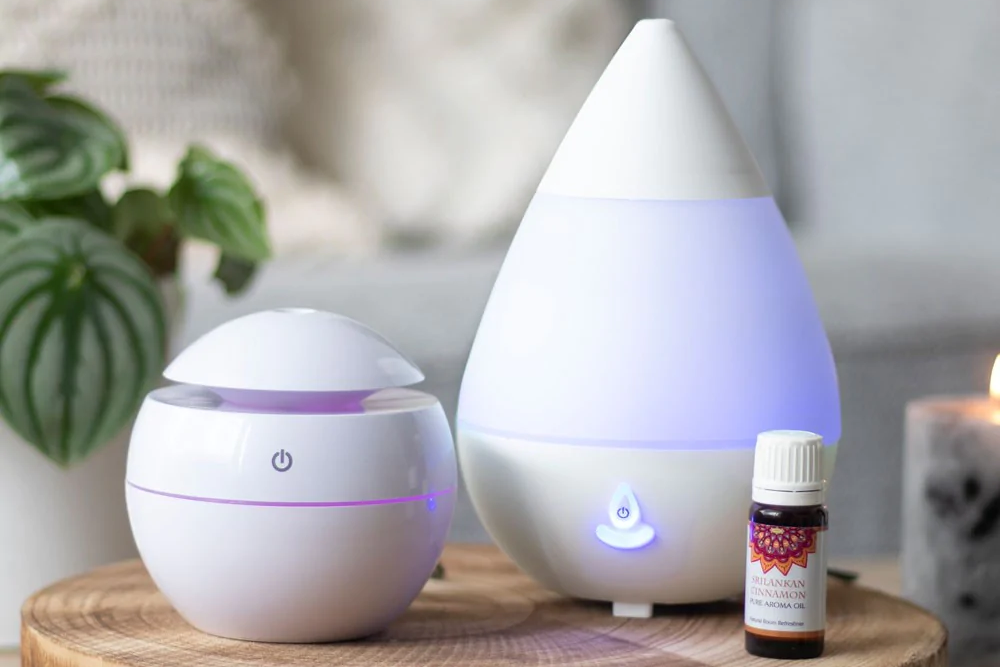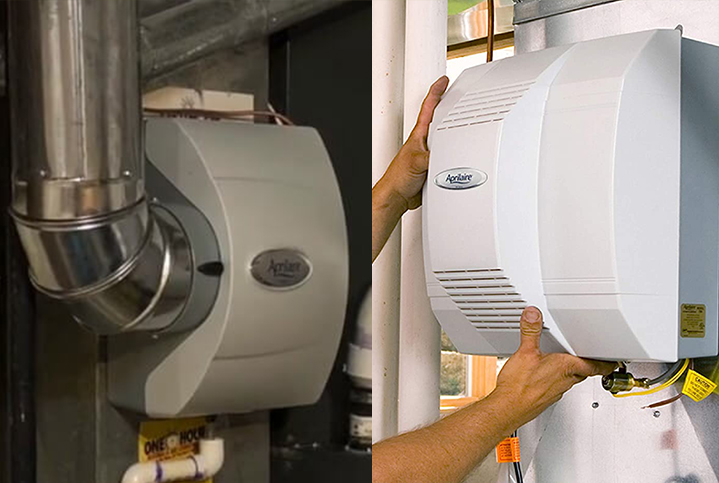

In winter, the air doesn’t contain very much moisture, especially when you’re running a furnace to keep your home warm. Air conditioners in summer can also decrease the humidity level. To replace the lost moisture in your home, you can use the best humidifier for a large room. Humidified air has health benefits as well, reducing coughs, sinus problems, and even asthma symptoms. You need to find the right one for the room you intend to use it in, to be sure it will work at its peak performance.
When choosing your new humidifier, there are a few features to look for to ensure it’s the right one for your home. The coverage area is probably the most important here. In a room smaller than the humidifier’s coverage area the machine can lead to mold and mildew. In a room that’s too big, the unit will just not humidify the air to the desired level. The tank capacity tells you how much water the unit can hold before needing to be refilled. How long the machine runs before a refill is necessary is also important, so you can time it right to keep your room at the optimal moisture levels. If it has a filter, this will need to be cleaned or replaced at specific times, so check if one is included.
To help you find the best humidifier for a large room, we spent countless hours checking out manufacturer’s information, reading customer reviews, and testing out the top models with the LEVOIT LV600HH as our Editor’s Choice. Then we created a comparison guide, including in-depth reviews, and added a buying guide to help you choose the right model for your home.
More features: touch control; built-in humidistat; whisper-quiet
For those who like multiple mist options, the Levoit LV600HH is an excellent choice. It allows you to choose between cool or warm mist, both of which have three different speed levels and an adjustable dual nozzle. The warm mist is created by an advanced PTC heating system, which heats the water in the tank high enough to kill most of the bacteria in the water, emitting cleaner, healthier air for your family to breath.
The tank itself has a large 1.5-gallon capacity, so you’ll likely only need to fill it every other day. A large opening makes it easy to fill and clean with a soft brush or a rag. This tank is made of ABS plastic, which is exceptionally durable.
The touch controls are simple to use, allowing you to change the speed, mist temperature, or set it to Auto or Sleep Mode as needed. You can also adjust the humidity level you want, with the actual RH displayed right on the LED screen. A remote control is also included, so you can set all the levels and speeds without leaving your chair or bed.
Other handy features are the auto shut-off when the tank is full and the whisper-quiet motor. The aroma box makes this model one of the best humidifiers for a large room with essential oils on the market.
More features: three speed settings; built-in humidistat; leak-free water tanks
If you have quite a large room that is in need of some moisture, this may be the best humidifier model for you. It has a vast coverage area of 1000 square feet, so fits in most bedrooms, living rooms, or kitchens. There are two two-gallon tanks, one on each side of the humidifier resulting in up to 24 hours of continuous runtime. This means you won’t have to fill those tanks every now and again.
Another benefit of these large tanks is that they are easy to fill from the tap or with filtered water. They have an airlock feature that eliminates spills and leaks, so you never have to worry about cleaning up any messes as your humidifier runs.
The controls include an On/Off button and two dials. One of these allows you to choose one of the three speed settings, while the other lets you adjust the humidity level. The Vornado Evap40 has a signature Vortex Action, which uses deep pitch blades to pull in the maximum amount of dry air, add moisture to it, and then circulates the humidified air throughout the room.
This may also be the best evaporative humidifier, thanks to the replaceable wick, which naturally humidifies the air pulled in through the fan. This adds the proper amount of moisture to the area, instead of shooting out over-humidified air and soaking nearby surfaces.
Additionally, you might want to take a look at other Vornado humidifiers, which boast excellent performance in larger rooms.
More features: top filling; whisper sleep mode; designed for a large room
Having a humidifier in your house has numerous merits. This Elechomes SH8820 Ultrasonic Top Fill Humidifier should be your top pick if you want a suitable unit for a large room.
The upgrades that this new unit from Elechnomes guarantees your safety during usage. Additionally, this humidifier permits you to fill the water tank directly from the top. This design is ergonomic and makes it easier to use this humidifier and to keep leakages away. The top filling also makes it easier for most people to operate this humidifier since you do not have to disassemble the unit to get this done.
The water tank capacity is 5.5L. This feature makes it possible for you to enjoy both cool and mist settings without worrying that this unit will run out of water. During winter, this humidifier will help unclog your sinuses and soothe sore throats. When it is summer, it plays a vital role in keeping your skin supple and your body fresh. This humidifier is a unit that you will find useful all year round.
This unit is compatible with essential oils; hence, you can mix your favorite with the water and enjoy the soothing as well as health benefits that these oils have.
More features: Trapmax filter technology with protection; automatically shuts off
The AIRCARE Space-Save Evaporative Humidifier is a unit with many stunning reviews from previous users. It features a simple design digital controls that make operation straightforward.
This unit is smart and knows to shut off when the humidity levels reach saturation automatically. Also, when the water dries up from the reservoir, the humidifier goes off. This feature is among those that make this unit desirable to a broader demographic. It helps prevent accidents in the home when you are asleep or raising the humid conditions to extreme levels.
The water tank capacity for this unit is six gallons, while the runtime is 70-hours. This means that you do not have to refill the water often or worry that the humidifier will malfunction from long hours of use.
The Trapmax Filter Technology that they use for this unit helps clean the air and mist before its release. It comes with protection to guarantee you the best quality of humidity in your home that is free of any contaminants or allergens.
The humidifier is best for large spaces as it can cover a 2700 sq—Ft area with ease. You cannot use any essential oils with this unit. This may be the only downside to getting this humidifier.
More features: cool mist; LED nightlight; auto shut off
If you are in the market for an affordable humidifier best for medium and small rooms, you are in luck. This Everlasting Comfort Ultrasonic Cool Mist Humidifier may be the answer to your needs.
It features a sleek design and easy to use controls that make operation a walk in the park. The coverage area for this unit is 500 sq. ft. It gives the best results when you adhere to this coverage limit.
The water tank has a capacity of 1.6 gallons. This is enough to cater to the coverage area. The 50-hours runtime is also another good quality of this humidifier. All these features work hand in hand to ensure that you achieve the optimal conditions in your home.
The design does not include a filter. This, however, does not mean that it does not do a good job. If you are keen on acquiring a unit with a filter, then this is not the humidifier for you.
This vaporizer humidifier is best for bedrooms and the baby nursery. It helps keep coughs and clogged sinuses at bay. Also, it has the auto shut off feature that helps maintain safety in the home. It turns off automatically when the humidifier runs out of the water, eliminating any damage to the unit.
More features: doubles as an air purifier; energy-efficient; three fan speeds
If you are looking for the best large room humidifier and air purifier combo for allergies, this model is a good option. The Venta LW25 pulls in dry, dirty air over the moistened Disc Stacks rotating inside the machine. Any bacteria, dust, or pollen floating in the air sticks to these stacks, then drops into the basin below. The clean, moistened air leaves the unit, increasing the room’s humidity level while it reduces allergens.
This type of humidifier uses Cold Evaporation technology, which won’t over-humidify the air. It doesn’t create cold mist or hot steam, either, so the air leaving the humidifier is the same temperature as the air in the room.
The Venta LW25 Airwasher uses the water in the tank to clean the air, so there are no filters to replace or clean. This makes this model one of the eco-friendliest humidifiers around, especially when you add in its low energy consumption.
The tank is located at the bottom of the machine, so you need to open it up and remove it to add more water. It runs for up to ten hours before refilling is needed, plus has an auto shut-off to keep it from running with an empty tank. A red LED light tells you it needs refilling. You’ll also have to add Venta’s cleaning solution to keep buildup from forming on the tank.
More features: remote control, 3 mist levels, 3 mist temperatures, low noise operation, timer, sleep mode
There’s no better way to relieve your body discomforts like eczema, dry skin, and nasal congestion caused by dry air than with the TaoTronics Humidifier. The versatile humidifier will also help you prevent common nuisances caused by dry air like cracked furniture and static electricity.
The humidifier boasts a neat and compact build. It packs a lot of power in its petite body. It can run up to 60 hours. With its generous water tank capacity of 1.58 gallons, you won’t have to worry about filling it up every other time.
Thanks to the humidifier’s compatibility with essential oils, you can enjoy your favorite scents.
Plus, the humidifier has an automatic humidity monitoring feature that will start and stop on its own to keep your humidity level at the optimum 55 to 65%. It is also fairly quiet; it only makes some noise when it starts.
One of the features you will mostly enjoy is the remote control. It allows you to adjust the humidifier’s settings without entering the room it is placed in.
Essentially, the humidifier features 3 mist levels and temperatures which offer you ultimate comfort all year round.
More features: smart timer, 3 mist levels, one-click sleep mode, convenient handle, super quiet operation
When it comes to true value for money, this Dreamegg humidifier is unbeatable. It is user-friendly and when filled up can run a good 35 hours. It is powerful enough for your living room, bedrooms or lounging area.
The humidifier comes in an elegant compact build. You will barely notice it in a room, plus it has a built-in nightlight that adds a touch of luxuriousness on it. Its compact build also means it is easy to move from one place to another. Its convenient handle also contributes to its easy portable.
Filling the humidifier’s water tank is a breeze. All you have to do is lift it up from the base, fill it up with 4.5litres of distilled water then place it back. It has 3 mist levels; low, medium and high and they are all perfect for different situations.
The dial on the top of the humidifier is its most interesting feature. You can turn it in any direction you want to direct the mist. It is also easy to remove for cleaning.
Cleaning the humidifier is a no brainer and it even comes with a brush.
If you are in the market for a new humidifier, check out the features, capacity, and tank size, to be sure you have the right model for the area you’ll be using it in. In the guide below you’ll learn more about each of the essential specifications.
If you have a large room that is need of some extra moisture in the air, you’re going to need a humidifier with a large coverage area. The larger the space you’re using it in, the higher this number needs to be. For instance, the Venta LW25 Airwasher 2-in-1 Humidifier and Air Purifier has a coverage area of 400 square feet. If you’re using it in a room that is smaller than this, the humidifier will work at its optimal level thanks to its Cold Evaporation technology that prevents the device from over-humidifying your room.
If the room is bigger than this maximum coverage area, the humidifier may take much longer to reach the desired humidity levels, or possibly not reach them at all.
When looking into a new humidifier, you’ll likely want to check the size of the tank. The bigger it is, the more water it can hold. The more water in the tank, the longer it can run before you need to refill it. The downside is that the larger tanks can be much heavier when you’re trying to haul a full one back to the humidifier from the sink. For this, the best top fill humidifier for a large room is much more convenient. Some models, like the Vornado Evap40, have two tanks instead of one. This makes them lighter to carry if they are bottom-filling tanks, without sacrificing the amount of water they can hold.
There are a few factors that determine the runtime of a humidifier. One is the size of the tank, as the bigger the tank, the more water there is to put through the machine. Another is the fan speed. The higher you have it set, the quicker the water will be dispersed through the room. The humidity setting is also something to consider. If you want to increase the humidity by only a few percent, the humidifier will do so and then shut off. Increasing the humidity by 20% will require the humidifier to run longer, so will use the water in the tank much faster, decreasing the runtime.
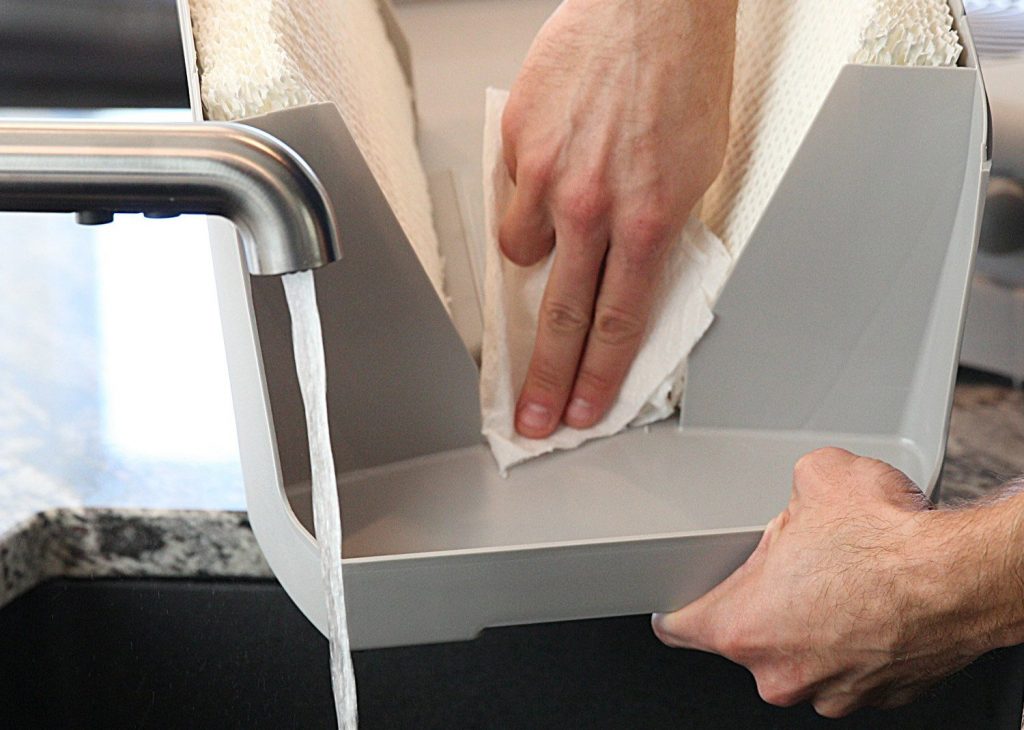
Filterless humidifiers don’t have that extra replacement cost and run quietly in most cases. Because they don’t take the dirt and bacteria out of the air in the same way, it can collect inside the humidifier. This will require a much more thorough cleaning every few days, to get rid of any buildup.
If you like to add a fresh, therapeutic scent to the air, putting a few drops of your favorite essential oil in the humidifier may seem like a good idea. Some models, like the Levoit LV600HH, have a separate aroma box, which holds the oils separate from the internal parts, misting them into the air on their own.
If your humidifier doesn’t have one of these, you may consider adding a few drops to the water tank. This is not a good idea, though. These oils can damage the plastic of the humidifier, plus can collect in the machinery, coating it and causing issues with how the humidifier works. This may lead to the breakdown of the machine, requiring a replacement much sooner than expected.
If your humidifier doesn’t have a separate space for essential oils, you can try moistening a cotton ball with your favorite oil, and place it over the mist outlet. As the humidifier releases the mist into the air, the scent will be diffused and released along with it. This method protects your humidifier while still giving you the option of using your favorite essential oils.
Most of the more portable humidifiers on the market today are made to be as quiet as possible, allowing you to use them in any room of your house without disturbing you, even in the bedroom. You need to consider the setting you’re using, though, as the higher the speed, the faster the fan will turn, creating more noise. This usually won’t affect your conversations too much, but if you are bothered by the noise, it may be best to keep the humidifier on the lower settings.
Every product you buy needs a decent warranty to cover any issues that may arise. Though usually, warranties won’t cover misuse or neglect of the machine, in most cases, they do cover any defects with the product or workmanship. Since many of these issues don’t show up for a while after you begin to use the process, the more extended the warranty, the more likely it is that any repairs or replacement costs will be covered. A one- or two-year warranty is fine, but a five-year guarantee, like the one included with the Vornado Evap40, covers you for almost any occurrence.
The primary purpose of a humidifier is to add moisture to the air in your home, but some models have a few additional features to make them more convenient and easier to use. One is a remote control, like the one that comes with the Levoit LV600HH. This allows you to change the settings from anywhere in the room.
An auto shut-off is also handy. There are a few types of auto shut-off. One turns off the humidifier when the tank is empty. Another turns it off when the desired humidity level is reached. Timer settings allow you to run the humidifier for a set amount of time, be it an hour or all day long. Different speeds will enable you to add moisture to the air slower or faster, as needed.
Some models have an oil diffuser, which lets you add essential oils to a separate compartment. This adds a lovely fragrance to the air as you increase the humidity levels.
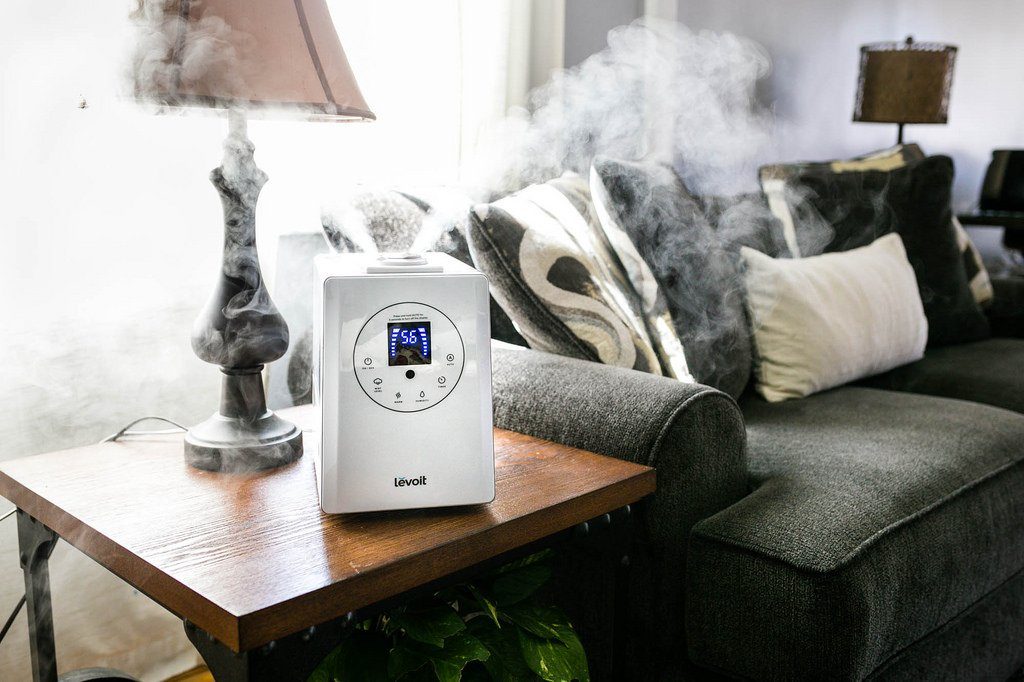
Having a humidifier in the larger rooms of your home doesn’t just add moisture to the air, it can help reduce a variety of health issues, like dry skin, nasal congestion, and coughing. All eight of the products we’ve reviewed are excellent options for this, but a few have a bit more to offer.
Our second top model is the Vornado Evap40, which holds four gallons of water in two spill- and leak-proof tanks. It uses Vortex Action to humidify the area quickly, with three speeds and an adjustable humidistat for the right amount of moisture. It also has a five-year limited warranty for added convenience.
The Levoit LV600HH, our Editor’s Choice, has both warm and cool mist options, a Timer and Sleep modes, and an aroma box for essential oils. It also allows you to use either touch controls and a remote control for more convenience.
The Elechomes SH8820 Ultrasonic Top Fill Humidifier has a 5.5 water tank allowing you to enjoy both cool and mist settings without worrying that this unit will run out of water.
